Who works at Codelco?
At Codelco, we value the responsibility and commitment of our employees, their competence, work excellence and their ability to work as a team. Therefore, we constantly develop and maintain highly motivated workers, able to comply with global performance excellence standards. Their professional and personal formation is fundamental, as is the promotion of their health, prevention of diseases, and the dissemination of healthy lifestyle practices.
(2.8 / LA1) 2.8 Dimensiones de la Organización, incluido: número de empleados, ventas netas, capitalización total y cantidad de productos o servicios prestados. In 2011, we had 63,311 workers, counting own employees (18,247 ) and contractor employees (45,064 ) who worked every day in various duties in the Corporation.
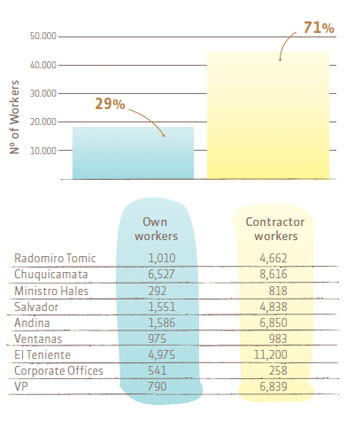
(4.1 / LA13)
4.1 Governance structure of the organization, including committees under the highest governance
body responsible for specific tasks, such as setting strategy or organizational oversight.
LA13 Composition of governance bodies and breakdown of employees per category according to
gender, age group, minority group membership, and other indicators of diversity.
The diversity of Codelco’s own endowment reflects the
constitution of workers according to age, gender, and position.
Women hold 10% of executive positions, and 8% of non-executive
positions.
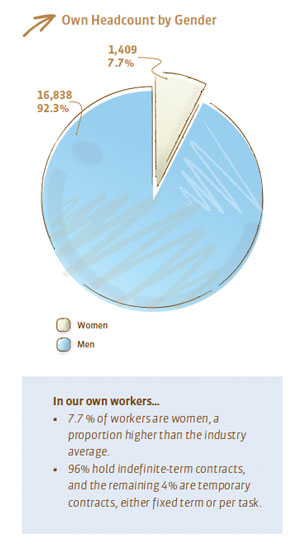
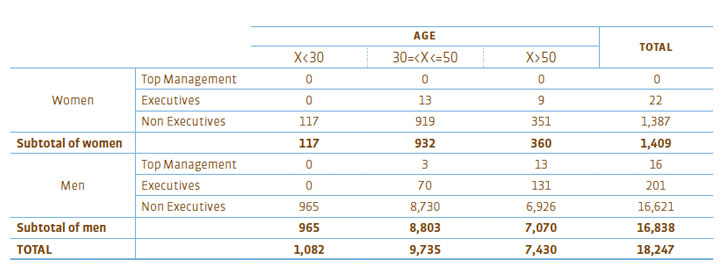
(LA14 / EC5)
LA14 Relación entre el salario base y la remuneración de mujeres y hombres, desglosado por categoría
de empleado, por ubicaciones significativas de actividad.
EC5 Ratio of basic salary and remuneration of women to men by employee category, by
significant locations of operation.
A comparison of earnings by gender is not pertinent, because
this is not a selection factor among same positions. Wages
may differ for other reasons, such as worker experience, performance,
competencies or skills.
WORKER MOBILITY
(LA2) Total number and rate of employee turnover by age group, gender, and region. During 2011, 2,464 direct employees left Codelco, representing a rotation of 13.5% compared to the total own headcount for the year.
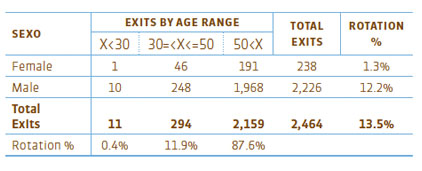
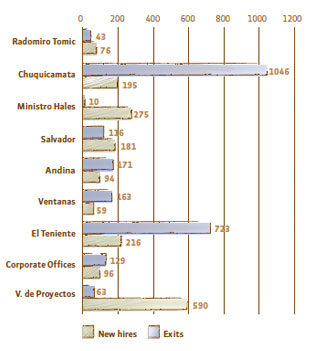
On the other hand, during 2011 1,782 own workers entered, 17% of them are women. Of these new hires, 3.6% (64 workers) left the Corporation during the same year.

(LA7 / LA15)
LA7Rates of injury, occupational diseases, lost days, and absenteeism, and number of workrelated
fatalities by region and gender.
LA15 Work reincorporation and retention levels after maternity leave or paternity leave,
disaggregated by gender.
In 2011, the absenteeism rate averaged 3.23 % for the
entire company, considerably less than in 2010 (3.7%). Part of
this absenteeism corresponds to parental leave, i.e. that granted
to all workers - men and women alike - when a child is born. A
total of 61 workers were absent due to this type of leave, 3.3% of
whom were men.
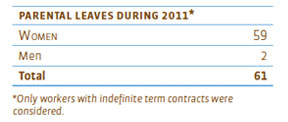
Retirement plans
(EC3)
Coverage of the organization’s defined benefit plan obligations. (R)
Within the framework of workers’ mobility, exits associated to
retirement plans are a step toward ensuring our competitiveness
in the long term. During 2011 we finalized a great process of voluntary
termination plans, offered to workers close to retirement
age, with low performance levels, or chronic occupational diseases.
These programs have a defined structure, and offer retirement
benefits, scholarships for children, training for improving employability,
and health coverage. This process, initiated in September
2010, allowed the termination of 2,453 workers through 2011.
(LA11) Programs for skills management and lifelong learning that support the continued and assist them in managing career endings. Exit plans included counseling on economic and pension matters, taking into account the interests, strengths and skills of the beneficiaries, as well as an analysis of new development opportunities, including entrepreneurship. Thus, many of those who left Codelco were recruited by other agencies to serve as consultants or expert advisers, while others were hired by universities to join their educational facilities.
![]()
New hires 2011
An important part of labor mobility is
made up of the incorporation of 1,704
new talents, attracted through apprenticeship,
graduate, expert, and emerging
leaders programs. The new recruits
generated an increase in the number
of women in all work areas, as well as
increasing the number of female executives
in the Corporation from 5 to 22 in
2011. Currently, at a senior level there is
a woman in each executive committee.